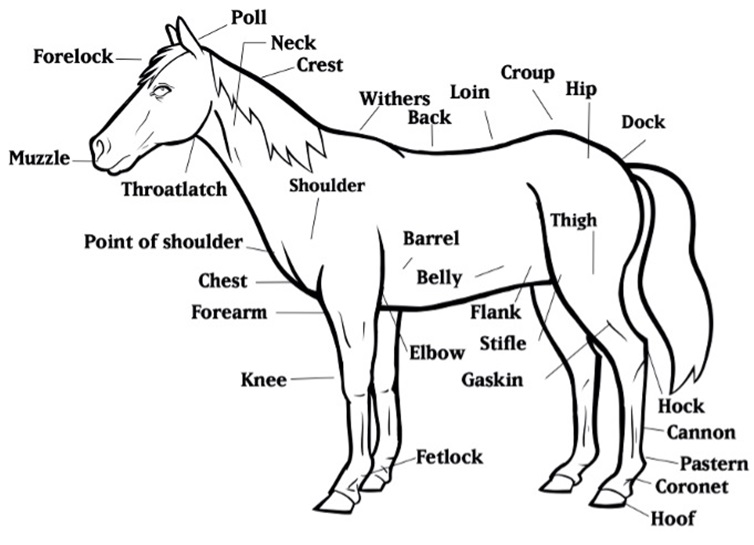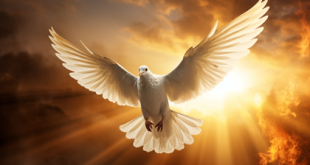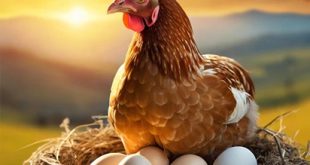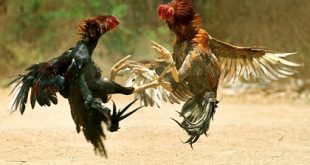Horses are magnificent creatures, admired for their strength, grace, and versatility. Each part of a horse’s body is uniquely designed to serve a specific purpose, enabling them to excel in various activities such as racing, working, or leisure riding. Understanding the anatomy and function of a horse’s body parts is crucial for horse owners, trainers, and enthusiasts to ensure proper care, training, and performance. Here, we delve into the key body parts of a horse and their respective functions.
A Body Part of A Horse

1. Head
The horse’s head plays an essential role in sensory perception and communication. It includes several key components:
- Ears: Horses have highly mobile ears that can rotate nearly 180 degrees. This ability allows them to detect sounds from various directions, a crucial trait for prey animals to sense potential predators. Their ears also communicate their mood—forward-facing ears indicate curiosity or alertness, while pinned-back ears signal irritation or aggression.
- Eyes: Positioned on the sides of the head, a horse’s eyes provide a wide field of vision, nearly 350 degrees. They have excellent night vision but limited depth perception. Horses rely on their vision to navigate their environment and assess threats.
- Nostrils: Large and flexible, the nostrils allow for efficient airflow during intense physical activities. Horses have a keen sense of smell, which helps them recognize individuals, detect food, and sense danger.
- Mouth: The mouth is integral for eating and drinking. Horses use their teeth to graze and their lips for picking up small objects or food. The tongue helps move food to the back of the mouth for swallowing.
2. Neck
The neck connects the head to the body and plays a critical role in balance and movement. A horse’s neck is composed of seven cervical vertebrae and strong muscles that:
- Aid in Balance: The neck acts as a counterbalance to the horse’s body, especially during sharp turns or sudden stops.
- Support Flexibility: Horses use their necks to adjust their head position for optimal vision and communication.
- Enable Grazing: The length and flexibility of the neck allow horses to lower their heads to the ground for grazing.
3. Withers
The withers are the ridge between a horse’s shoulder blades, located at the base of the neck. This part of the body is important for several reasons:
- Measuring Height: A horse’s height is measured at the withers, from the ground to this highest point of the shoulder.
- Saddle Fit: Proper saddle placement begins at the withers to ensure comfort and prevent injury.
- Support for Movement: The withers are part of the horse’s skeletal structure that helps distribute the rider’s weight evenly.
4. Back
The back is a crucial area that supports the rider or load. It includes the thoracic and lumbar vertebrae and is covered by layers of muscle and tissue.
- Supports Weight: The back must be strong enough to carry a rider without strain. Proper conditioning is essential to avoid back injuries.
- Facilitates Movement: The back’s flexibility aids in the horse’s overall mobility, including bending and turning.
- Indicator of Health: A horse’s back can reveal signs of discomfort, poor saddle fit, or muscular issues through swelling, soreness, or tension.
5. Chest and Thorax
The chest houses vital organs such as the heart and lungs. This area is designed for endurance and strength:
- Respiration: The ribcage protects the lungs, allowing for efficient breathing during high-intensity activities.
- Circulation: The chest supports the powerful heart, which pumps blood throughout the body, sustaining energy levels.
- Muscle Attachment: The chest provides attachment points for muscles that control leg movement.
6. Legs and Hooves
Perhaps the most critical components for a horse’s mobility, the legs and hooves are marvels of engineering.
- Forelegs: These bear about 60% of the horse’s weight. The forelegs include the shoulder, elbow, knee, cannon bone, fetlock, pastern, and hoof.
- Shock Absorption: The forelegs absorb impact during movement, protecting the horse’s body.
- Flexibility and Strength: The joints and tendons allow for a wide range of motion, essential for activities like jumping and galloping.
- Hind Legs: These provide propulsion and power. Key parts include the stifle, hock, cannon bone, fetlock, and hoof.
- Driving Force: The hind legs generate the thrust needed for running and jumping.
- Balance: They help stabilize the horse’s body, especially during quick maneuvers.
- Hooves: Often referred to as the “foundation” of the horse, hooves protect the sensitive inner structures of the feet.
- Weight Distribution: Hooves distribute the horse’s weight evenly, reducing stress on the legs.
- Traction: The hard outer shell and frog (a V-shaped structure) provide grip and stability on various terrains.
- Shock Absorption: The hoof’s internal structures, including the digital cushion, help absorb impact forces.
7. Abdomen
The abdomen contains the digestive system, including the stomach and intestines. It plays a vital role in:
- Digestion: Horses are grazing animals with a complex digestive system designed for constant, small meals. Proper nutrition and feeding practices are essential to avoid colic or other digestive issues.
- Support for Pregnancy: In mares, the abdomen supports the developing foal during pregnancy.
8. Tail
The tail is an extension of the horse’s spine and is composed of vertebrae, muscles, and hair. It serves multiple functions:
- Communication: Tail movements can indicate mood—a relaxed tail shows calmness, while a swishing tail may signal irritation.
- Fly Control: Horses use their tails to swat away flies and other pests.
- Balance: During movement, the tail helps maintain balance, especially during sharp turns or sudden stops.
9. Skin and Coat
The skin and coat serve as the horse’s first line of defense against external elements.
- Protection: The skin shields against injury, insects, and harmful UV rays.
- Temperature Regulation: The coat helps insulate the horse in cold weather, while sweat glands aid in cooling during hot conditions.
- Sensory Function: The skin contains nerve endings that provide sensory feedback, helping the horse respond to touch and environmental changes.
10. Muscular System
The horse’s muscular system is responsible for movement, strength, and endurance. It works in conjunction with the skeletal system to perform various activities:
- Locomotion: Muscles power the legs, neck, and back, enabling the horse to walk, trot, canter, or gallop.
- Posture: Core muscles help maintain posture and stability, whether the horse is standing or in motion.
- Flexibility: Muscle groups enable the horse to bend, stretch, and perform intricate movements required in disciplines like dressage.
Conclusion
A horse’s anatomy is a fascinating combination of form and function, perfectly adapted to its lifestyle as a prey and performance animal. Each body part plays a vital role in maintaining the horse’s health, mobility, and well-being. By understanding these functions, caretakers can better appreciate the complexity of these animals and provide the care and attention they need to thrive.


